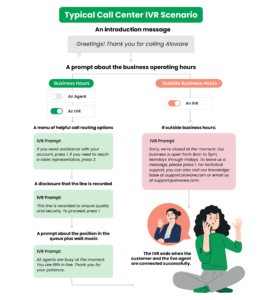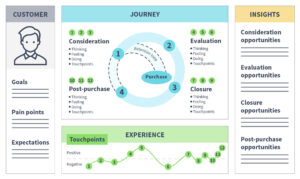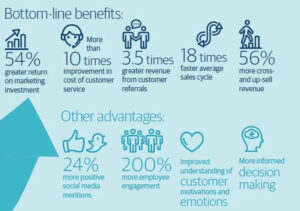In today’s highly competitive digital landscape, understanding the customer journey is more crucial than ever. Businesses strive to provide seamless experiences that lead to higher conversion rates and long-term loyalty. One powerful tool that plays a pivotal role in achieving this is call tracking. While often associated with just measuring phone calls, call tracking is much more than that—it’s an essential component in mapping out the customer journey and gaining actionable insights.
What is Call Tracking and Why Does It Matter?
Call tracking is the practice of using technology to monitor, record, and analyse phone interactions between customers and businesses. It helps identify which marketing channels are generating the most calls and how those calls contribute to a company’s sales and overall customer experience. Call tracking provides businesses with critical data that goes beyond metrics like click-through rates or impressions and offers a deeper understanding of customer behavior.
The insights from call tracking can illuminate various stages of the customer journey—from the first touchpoint to the final purchase decision. By analysing this data, businesses can pinpoint opportunities for improvement, optimize their marketing efforts, and enhance the overall customer experience.
How Call Tracking Enhances Customer Journey Mapping
Customer journey mapping is the process of visualizing and understanding the complete experience a customer has with a business, from initial awareness to post-purchase interactions. Incorporating call tracking into this process allows companies to create a more comprehensive map that includes both digital and voice interactions. Here’s how call tracking enhances customer journey mapping:
1. Uncovering the Full Path to Purchase
While online analytics tools can track user behavior on websites and apps, they often overlook what happens when customers switch to a phone call. Call tracking bridges this gap by providing data on how many calls came from specific marketing campaigns, ads, or channels. This helps businesses understand the entire path customers take to conversion, not just the online portion.
2. Identifying the Most Effective Marketing Channels
Call tracking allows businesses to attribute calls to the specific channels or campaigns that generated them. This attribution can help determine which marketing efforts are driving the most valuable leads. For example, if a company runs paid social media ads, email marketing campaigns, and PPC ads, call tracking can show which channel is leading to the highest number of quality calls. This data can guide businesses in allocating budget more effectively and refining their marketing strategy.
3. Enhancing Customer Segmentation
By capturing caller information, such as location, demographics, and interests, businesses can segment customers more accurately. This segmentation helps in tailoring communication strategies that resonate with different audience groups. For instance, if data from call tracking shows that customers in a particular region are more likely to call in response to a specific type of campaign, businesses can develop targeted follow-ups or localized promotions.
4. Improving Customer Experience Through Data
Call tracking provides valuable insights into the customer experience. By recording and analysing calls, businesses can pinpoint common questions, concerns, and pain points that customers have during their journey. For example, if many callers express confusion about a product feature or service, it signals a need for better content, clearer communication, or enhanced training for customer service teams.

Best Practices for Leveraging Call Tracking in Customer Journey Mapping
To maximize the benefits of call tracking in customer journey mapping, businesses should follow these best practices:
1. Integrate Call Tracking with Other Data Sources
Combining call tracking data with website analytics, CRM systems, and other customer data sources offers a holistic view of the customer journey. This integration allows businesses to correlate phone interactions with online behavior, creating a more nuanced map that highlights key touchpoints across channels.
2. Use Call Recording and Transcription for Deeper Insights
Advanced call tracking systems often come with features such as call recording and transcription. These tools can provide qualitative data that goes beyond numbers, helping businesses understand the context and sentiment behind customer interactions. Analyzing these transcriptions for keywords and themes can reveal recurring questions or issues that customers face, leading to more effective solutions.
3. Leverage Real-Time Data for Immediate Action
Call tracking systems that offer real-time reporting enable businesses to act swiftly on emerging trends. For instance, if a marketing campaign is generating an influx of calls, businesses can monitor the calls in real time and adjust their strategies accordingly. This responsiveness ensures that companies can optimise customer experiences while the campaign is still running.
4. Implement Feedback Loops for Continuous Improvement
Feedback loops play a crucial role in refining customer journey mapping. By using call tracking data to identify strengths and weaknesses, businesses can make iterative changes to their marketing campaigns and customer service processes. Regularly revisiting call tracking insights ensures that businesses stay agile and adapt to shifts in customer expectations.
Challenges and Considerations When Using Call Tracking
While call tracking offers numerous advantages, it’s not without its challenges. Here are a few considerations that businesses should keep in mind:
1. Data Privacy and Compliance
With regulations such as GDPR and CCPA, businesses must be mindful of how they collect and handle customer data. Ensuring that call tracking practices comply with these laws is essential to protect customer privacy and avoid legal repercussions.
2. Balancing Automation with Human Interaction
While call tracking can provide valuable data, it’s essential to balance automated insights with genuine human interaction. Too much emphasis on data-driven strategies can lead to a robotic customer experience. Combining data insights with empathy and personal touch can help maintain a high-quality customer journey.
3. Choosing the Right Call Tracking Solution
Not all call tracking solutions are created equal. It’s important for businesses to choose a platform that aligns with their specific needs and integrates seamlessly with existing systems. Features like call recording, transcription, and advanced analytics should be evaluated based on their contribution to customer journey mapping goals.
The Future of Call Tracking and Customer Journey Mapping
As technology advances, so too will the capabilities of call tracking. The future promises even deeper integration with AI and machine learning, enabling businesses to predict customer behavior and personalize experiences more effectively. Automated sentiment analysis will allow companies to gauge customer emotions in real-time, further enhancing the customer journey map.
Innovations such as voice search optimization and voice-activated technology will also play a significant role in how businesses approach call tracking. These developments will make it easier for companies to understand and predict customer needs, creating opportunities for even more tailored customer experiences.

Future Trends in Call Tracking and Customer Journey Mapping
As technology continues to advance, the landscape of call tracking and customer journey mapping is set to evolve. Future innovations will likely focus on integrating call tracking data with AI-driven analytics platforms to create even more dynamic and detailed customer maps. This integration will enable businesses to predict customer behavior with greater accuracy and personalise the user experience in real-time.
The use of AI and machine learning will help in the analysis of call conversations, allowing for deeper insights into customer sentiment, intent, and pain points. Advanced speech recognition and natural language processing (NLP) will not only transcribe calls but also understand context and emotions, making it easier for businesses to respond to customer needs more effectively. This will result in more nuanced journey maps that reflect not just actions but also the emotions and motivations behind them.
Enhancing Personalisation Through Call Tracking Data
One of the most significant advantages of call tracking is its potential to enhance personalisation across various touchpoints in the customer journey. By analysing data from phone interactions, businesses can better segment their audience and tailor marketing messages that resonate on a personal level. Call tracking can reveal common questions, concerns, or objections customers may have, which can then be addressed through personalised follow-up communications or targeted content.
For example, if a business notices a recurring question in calls related to product features or pricing, they can create detailed blog posts or video content that answer these questions in advance. This proactive approach not only boosts customer satisfaction but also establishes the brand as a knowledgeable and reliable source of information. The more businesses use call tracking data to customise their outreach, the more effective their marketing strategies become.
Integrating Call Tracking with Omnichannel Marketing Strategies
To achieve a truly seamless customer journey, businesses must integrate call tracking data with their omnichannel marketing strategies. An omnichannel approach ensures that customer interactions across different platforms—whether social media, email, or live chat—are connected and consistent. Call tracking data can provide a comprehensive overview of how customers move through various channels before picking up the phone, allowing businesses to identify the most effective paths to conversion.
Combining call tracking data with other analytics tools can help identify gaps or bottlenecks in the customer journey. This data can then be used to optimise campaigns, improve user experience, and ensure that customers have a consistent experience regardless of the touchpoint. The integration of call tracking within an omnichannel framework provides a holistic view of the customer’s path, making it easier for businesses to identify pain points and make necessary adjustments.
Overcoming Challenges in Call Tracking and Customer Journey Mapping
While the benefits of call tracking are clear, businesses may face challenges when integrating this tool into their overall marketing strategy. One major challenge is ensuring data privacy and compliance with regulations like the General Data Protection Regulation (GDPR) and the California Consumer Privacy Act (CCPA). Businesses must be diligent about obtaining consent for call tracking and being transparent about how customer data is used.
Another challenge is ensuring that call tracking data is accurately interpreted and integrated with other data sources. Inconsistent data formatting or poor integration can lead to gaps in the customer journey map, resulting in incomplete or misleading insights. To overcome this, businesses should use reliable and well-integrated call tracking platforms that offer robust data analysis tools and reporting capabilities.
Optimising Call Tracking for Better Customer Experiences
To get the most out of call tracking, businesses should follow best practices that ensure high-quality data collection and analysis. This includes training customer service representatives to handle calls professionally and consistently, as well as maintaining an organised system for logging and categorising call data.
Additionally, businesses should leverage call tracking to measure and improve customer service quality. By identifying common issues or questions raised during calls, companies can better train their teams and improve the overall customer experience. This not only enhances the customer journey but also increases the likelihood of repeat business and positive word-of-mouth referrals.
Leveraging Call Tracking for Proactive Customer Engagement
One of the most impactful ways businesses can use call tracking data is to engage with customers proactively. Instead of waiting for customers to reach out with questions or concerns, businesses can use call data to anticipate customer needs and provide relevant information. For instance, if a customer has called to inquire about a specific product or service, the business can send them a follow-up email or message with helpful content, special offers, or personalised recommendations.
This type of proactive engagement helps build customer trust and fosters long-term relationships. It positions the business as attentive and customer-focused, enhancing the overall customer experience and increasing the chances of retaining loyal customers.
Utilising Call Tracking for Performance Metrics and ROI
Finally, call tracking data is a powerful tool for measuring marketing performance and calculating return on investment (ROI). By connecting call data with campaign metrics, businesses can gain insights into which marketing channels are driving the most high-quality calls. This enables them to allocate resources more effectively and focus on strategies that yield the best results.
Businesses can also use call tracking to assess the effectiveness of specific ads, keywords, or content pieces. For instance, if a particular PPC ad generates a high volume of calls, the business can adjust its budget to allocate more resources to that ad or campaign. This data-driven approach ensures that marketing efforts are continuously refined to maximise ROI and overall campaign success.

The Unmatched Value of Call Tracking in Customer Journey Mapping
The impact of call tracking on customer journey mapping is profound and multifaceted. By integrating call tracking data with other marketing and customer service efforts, businesses can create a comprehensive map that reflects the entirety of the customer experience. From uncovering the most effective marketing channels to enhancing segmentation and improving the customer experience, call tracking is an indispensable tool in the modern marketer’s toolkit.
As businesses continue to adapt to changing consumer behaviors and technological advancements, the role of call tracking will only become more crucial. By leveraging this powerful tool, companies can build stronger relationships with their customers and drive growth through insightful, data-driven strategies.



